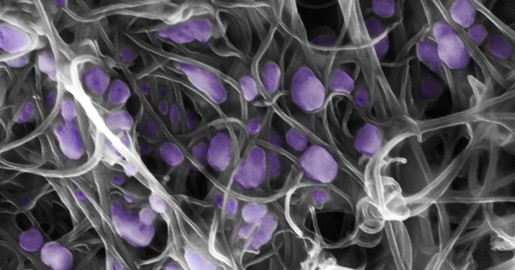12/01/2016 09:00 AM EST

The purple pods that you see in this scanning electron micrograph are the H5N2 avian flu virus, a costly threat to the poultry and egg industry and, in very rare instances, a health risk for humans. However, these particular pods are unlikely to infect anything because they are trapped in a gray mesh of carbon […]
Snapshots of Life: Virus Hunting with Carbon Nanotubes

Credit: Penn State University
The purple pods that you see in this scanning electron micrograph are the H5N2 avian flu virus, a costly threat to the poultry and egg industry and, in very rare instances, a health risk for humans. However, these particular pods are unlikely to infect anything because they are trapped in a gray mesh of carbon nanotubes. Made by linking carbon atoms into a cylindrical pattern, such nanotubes are about 10,000 times smaller than width of a human hair.
The nanotubes above have been carefully aligned on a special type of silicon chip called a carbon-nanotube size-tunable-enrichment-microdevice (CNT-STEM). As described recently in Science Advances, this ultrasensitive device is designed to capture viruses rapidly based on their size, not their molecular characteristics [1]. This unique feature enables researchers to detect completely unknown viruses, even when they are present in extremely low numbers. In proof-of-principle studies, CNT-STEM made it possible to collect and detect viruses in a sample at concentrations 100 times lower than with other methods, suggesting the device and its new approach will be helpful in the ongoing hunt for new and emerging viruses, including those that infect people.
The new device is the result of a long collaboration at Penn State University, University Park, involving experts in materials science, physics, chemistry, infectious diseases, and genomics. The work was led by NIH grantees Mauricio Terrones and Si-Yang Zheng, who received additional support from an NIH Director’s New Innovator Award.
As Terrones and Zheng explained, carbon nanotubes are an ideal material to catch viruses because they are incredibly flexible and strong. They reportedly having the highest strength-to-weight ratio of any known material, which allows them to compress and bend without breaking when they encounter a virus. Another big plus is the team members can construct carbon nanotubes right on their device, controlling the distance between nanotubes with exquisite precision and, thereby, tailoring each device to the particuar size of the viruses being hunted.
To put CNT-STEM to a real-world test, Terrones and Zheng examined samples from five wild ducks in Pennsylvania, which were collected as part of a surveillance effort to track the evolution and spread of influenza viruses that could potentially cause illness in domestic poultry and/or people. They uncovered an emerging H11N9 strain of avian influenza, which couldn’t be detected by other techniques.
In a second case study, the researchers used CNT-STEM to search for viruses possibly present in a sample taken from the eyelid of a sick turkey. Earlier attempts to diagnose the turkey, which was suffering from swollen lesions of suspected viral origin, came up negative. After using the new approach to capture potential viruses in the sample, the team’s genetic analysis identified a completely novel viral strain.
CNT-STEM is lightweight and portable. It also doesn’t require any special storage, antibodies, or other chemical reagents. All of these features make it ideal for use in the field, wherever a suspected viral infection pops up. The researchers have immediate plans to work with the U.S. Department of Agriculture to apply their device in the search for viruses that may be a threat to plants, crops, and food.
It’s already feasible to make up to 1,500 of the devices per week for just a few dollars each. The next task is to scale up production, while continuing to evaluate possible refinements to the device and its technological capabilities.
Reference:
[1] Tunable and label-free virus enrichment for ultrasensitive virus detection using carbon nanotube arrays. Yeh YT, Tang Y, Sebastian A, Dasgupta A, Perea-Lopez N, Albert I, Lu H, Terrones M, Zheng SY. Sci Adv. 2016 Oct 7;2(10):e1601026.
Links:
Bird Flu (MedlinePlus, National Library of Medicine/NIH)
Terrones Research Group (Penn State University, University Park, PA)
Zheng Research Group (Penn State University, University Park, PA)
NIH Support: National Center for Advancing Translational Sciences; National Cancer Institute; Common Fund





















.jpg)












No hay comentarios:
Publicar un comentario